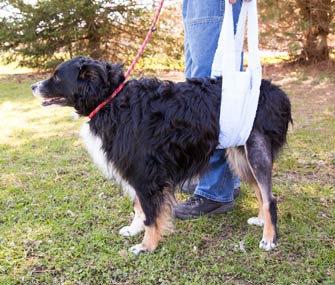Rehabilitation: Renewal for Stiff and Achy Pets
Published on April 07, 2017

Rusty just wasn’t herself any more. At 10 years of age, the once-active Sheltie lagged behind on walks. She was reluctant to jump onto the bed and couch. And she refused to sit, even when her favorite treat was dangled above her. When pain medications alone didn’t improve the situation, her veterinarian recommended adding rehabilitation.
“Rehabilitation gives the opportunity of maximizing return to function, even for patients with permanent impairments,” according to Dr. Julia Tomlinson, a board-certified specialist in rehabilitation and sports medicine and president-elect of the American College of Veterinary Sports Medicine and Rehabilitation, who treated Rusty after she was referred from her primary veterinarian.
As rehabilitation increasingly becomes part of the therapeutic mix, some general practice veterinarians now offer a few services, and a growing number of specialty practices are popping up, staffed by board-certified veterinary specialists who have advanced training in sports medicine and rehabilitation.
Like physical therapy in humans, rehabilitation helps restore mobility and function by focusing noninvasive therapies on muscles, bones, joints, and the tissues associated with them, such as ligaments, tendons, and nerves. Although pain medication is often an important part of therapy, Dr. Tomlinson points out that rehabilitation itself can also help to reduce pain for many pets.
Clinic Therapy With Homework
When examined by a veterinarian, Rusty was stiff and painful in her lower back and pelvis, and her muscles would spasm when those areas were manipulated. At the Twin Cities Animal Rehabilitation and Sports Medicine Clinic in Minnesota, she underwent laser therapy and joint mobilization and manipulation to help improve limb movement. Her pet parents were taught gentle traction techniques to perform at home with her.
“Within 2 weeks, she was feeling much better, managing a full walk with enthusiasm, and getting on the bed again,” reports Dr. Tomlinson. At that point, Rusty was prescribed at-home exercises to bolster her flexibility and strengthen her rear legs and core muscles.
“Owners often think all treatments have to be done in the clinic,” says Dr. Tomlinson. “They underestimate what can be done at home with our guidance.” That perception, along with another misconception — that rehabilitation is always expensive — often prevents pet parents from pursuing rehabilitation. “In fact, it can be one of the least expensive of all veterinary specialties,” she says.
Help For A Wide Range Of Conditions
When combined with appropriate medical treatment, including effective management of pain and inflammation, rehabilitation can help pets recover from injuries or surgery, such as a cruciate ligament or spinal repair. Pets with other conditions that aren’t amenable to surgery, including osteoarthritis and obesity, may also benefit from therapy. “Research shows that dogs lost more weight with diet and in-clinic exercise therapy than with diet and at-home exercise alone,” says Dr. Tomlinson. “Therapeutic exercise also helps to prevent loss of lean body mass, or muscle, in the face of calorie restriction.”
Rehabilitation specialists often practice sports medicine as well, which applies athletic conditioning to help maintain fitness or prevent injury in sporting or working dogs. And small animal rehabilitation isn’t just for canines. “We see cats mostly for spinal pain and stiffness, some for diseases of the nervous system and hip arthritis, and some for orthoses, or braces,” says Dr. Tomlinson.
Finding The Right Therapist
It may be tempting to assume that anyone, such as a technician trained in human massage or physical therapy, can provide rehabilitation for pets, but that’s not the case. “Not all people who advertise as animal rehabilitation therapists are adequately qualified,” warns Dr. Tomlinson. “The patient needs a veterinary diagnosis,” she adds, stressing the importance of working with veterinarians who have specific training.
That’s why you’ll want to first schedule a visit with your veterinarian: to make sure your pet gets a proper diagnosis and ultimately works with someone who will help you reach the goals you and your veterinary team set together to help alleviate your pet’s pain, restore function, and improve her quality of life.
Working with the right therapist certainly paid off for Rusty. “Two years on, she’s still getting on the couch and bed, loving walks, and having no pain issues,” says Dr. Tomlinson, who now sees Rusty only every 3 months.
This article originally appeared in the Fall 2016 issue of HealthyPet magazine.
More on Vetstreet:





